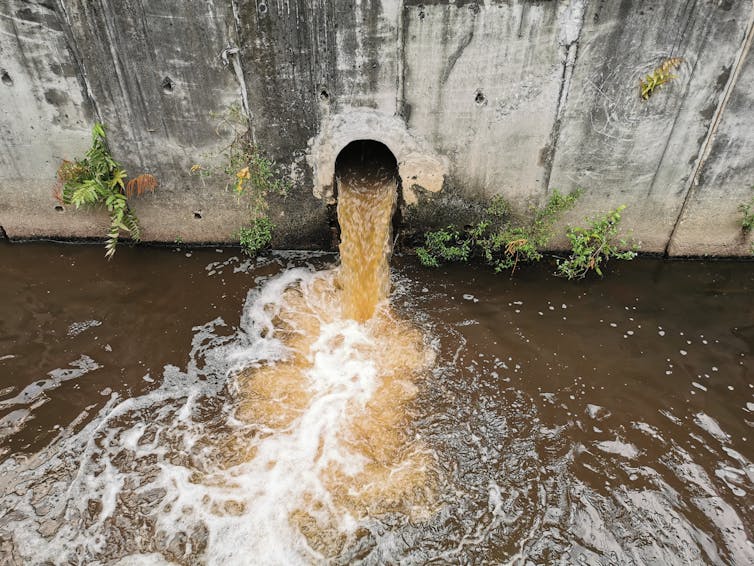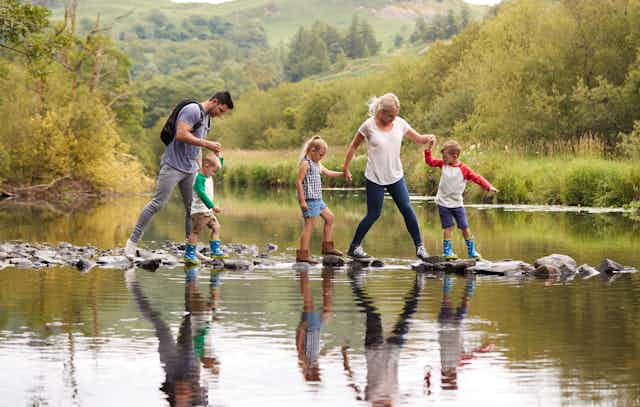England’s rivers are in a mess. Just 14% are in good ecological condition – and that’s just the ones that are regularly assessed.
There are many reasons for this. They include growing pressure on ageing sewer systems from housing developments and extreme weather, misconnected drains, intensive livestock and poultry farms, the flushing of wet wipes, and illegal waste dumping and littering.
In the older parts of English cities, combined sewers carry wastewater flushed from homes and public buildings with the water that runs off pavements and into drains.
To prevent flooding, overflows are permitted to release excess water into rivers when combined sewers cannot cope with a deluge. Via these overflows, urban runoff blended with sewage entered rivers and the sea on average 825 times a day in 2022.
Swimming in rivers or wading and splashing around in streams is one of the most pleasant things you can do on a hot summer day. Unfortunately, the bacterial water quality of England’s rivers is not routinely tested by authorities unless it contains an officially designated bathing site.
To assess the risk in my own city, Newcastle upon Tyne in north-east England, my research team and I undertook an extensive study to monitor the bacteria living in the river Ouseburn.
We collected 40 water samples from the Ouseburn’s course in the summer and early autumn of 2021 at eight locations, including where the river flows through Newcastle’s most popular park.
We found that water discharged from storm overflows contained a high concentration of faecal bacteria – about one hundred times higher than the acceptable standard for bathing water.
The river’s bacterial community shifted from predominantly freshwater species during dry weather to mostly sewage bacteria during heavy rain, when sewers were inundated and storm overflows were activated.
During one September storm, 72-77% of all bacteria in the Ouseburn downstream of storm overflows originated from the sewer system. Sewage bacteria in the river reached levels observed in storm overflow discharge, which implies that the natural flow of the river only slightly dilutes these discharges.
Levels of sewage bacteria fell substantially 24 hours after rainfall, but overall the Ouseburn would probably fail water quality standards if it were monitored as bathing water. People who accidentally ingest water when wading and splashing in the Ouseburn could contract diarrhoea or another gastrointestinal disease.
To avoid getting sick, here are five things you should do before entering a river.
1. Check for storm overflows
Water and sewerage companies in England and Wales update the Environment Agency on how long their storm overflows discharge over the course of a year. The Rivers Trust charity compiles this information in its sewage map.

Check this map for storm overflows that frequently discharge upstream of where you plan to swim. Keep in mind that the water in rivers moves fast over great distances. Our work suggested that the sewage didn’t dilute all that much downstream of the main discharge point over a stretch of river several kilometres long.
2. Consider the size of the river – and what surrounds it
Small rivers flowing in urban areas receive less water from their catchment than larger ones to dilute sewage. As our work showed, concentrations of sewer-related bacteria in a small urban river can be very high when it rains.
3. Look out for sewage litter
Plastic litter derived from sewage, such as wet wipes and sanitary products, is a sign that the sewer system is discharging into a river. This kind of litter is often tangled in tree roots or other vegetation along the high-flow line, or dumped on embankments that flood during storms.

4. Avoid rivers during and after storms
Heavy rain can cause storm overflows to release sewage, so avoid rivers during and after heavy rain (and flooded areas if a river has left its embankment). In a thunderstorm, heavy showers can fall upstream while the weather remains sunny even a short distance downstream. So avoid rivers when conditions are thundery.
5. Avoid cloudy water
We found that cloudier water tended to have more sewer bacteria. While rivers can be naturally cloudy following rainfall, it is often a sign of water pollution, not just from sewers but also farms.
These five tips should help you recognise the signs of pollution from sewers that could make you sick. You should also consider the risks of slips, trips and falls when venturing into a stream. Or the risk of drowning in deeper rivers. A river’s depth can change within a single step, currents can speed up, and cold temperatures can cause shock. Branches, boulders, and other hazards could be lurking out of sight.
Connecting with nature can benefit your mental health. To do this safely in England’s rivers, take these precautions.

